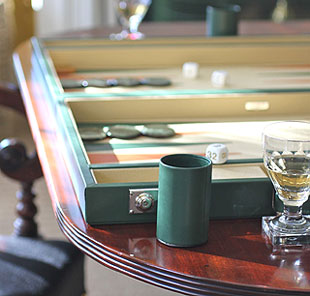|
| Magriel's NYT Columns |
 The seventh Big Apple Backgammon Championship, sponsored by the Metropolitan Backgammon Association, was held recently in New York. Mike Singer defeated Moshe Horowitz to take first place in the championship division; Robert Bishop and Lee Fine were semifinalists. Andy Palumbo overcame Don Kandel in the consolation; Jay Davis beat David Dana in the intermediate.
The seventh Big Apple Backgammon Championship, sponsored by the Metropolitan Backgammon Association, was held recently in New York. Mike Singer defeated Moshe Horowitz to take first place in the championship division; Robert Bishop and Lee Fine were semifinalists. Andy Palumbo overcame Don Kandel in the consolation; Jay Davis beat David Dana in the intermediate.
The 11-point finals match was anticlimactic as Mike Singer routed his opponent 11 to 1. His 9-point semifinals match, however, was suspenseful and hard fought.
Indeed, after the diagrammed position was reached, Singer was fortunate to survive. With the score tied 7 to 7, Black (Horowitz) had only to complete his bearoff safely to win the match. The only hope for White (Singer) was to hold the 3-point and hope for a shot.
|
7
MATCH TO 9 7 |
| Black to play 6-2. |
|
|
|
In general, bearing off safely against a 3-point is not nearly so dangerous as against a 1- or a 2-point. Usually, any difficulty comes from the inability to play 3’s. To keep from getting into such a “3 squeeze,” it is wise for Black to avoid having extra men on the 6-point.
In the actual game, Black next rolled 6-4, which he safely played 6/off, 5/1, but this left him “stripped down” with no extra men on his three highest points. The following roll, 6-3, was a disaster. Black was unable to avoid exposing two men to a double direct shot. White hit one man and eventually closed Black out to win the game and the match.
Rollout
 Tom Keith 2013 |
|
Match to 9 White 7, Black 7 White owns 2-cube Black rolls 6-2 1296 games with VR Checker play: 2-ply Cube play: 3-ply Red |
| 6-2: | Game | G | BG | Equity | ||||
| 1 | 6/4, 6/off |
W L |
.8858 .1142 |
.7830 .0000 |
.0300 .0000 | +0.7717 |

| (a) |
| 2 | 6/off, 2/off |
W L |
.8691 .1309 |
.7648 .0000 |
.0301 .0000 | +0.7381 | (0.0336) | (b) |

|
|

